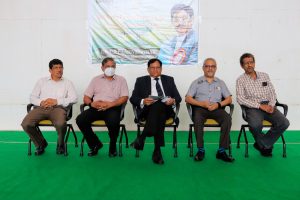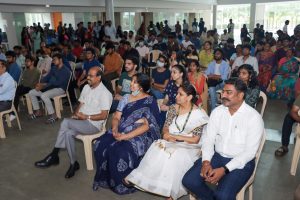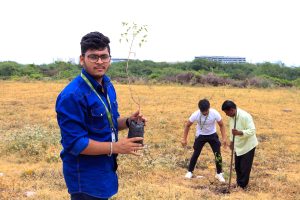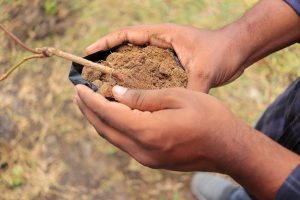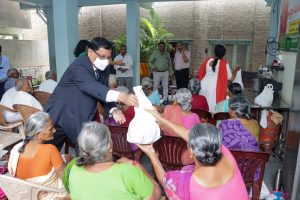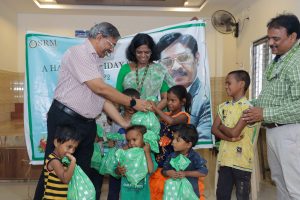SRM-AP All News
ALL News
- Modified solar air heater for preserving agricultural produce September 5, 2022

There is a growing demand for decentralised systems that use renewable energy to extend the shelf life of agricultural commodities. Solar Air Heating systems (SAHs) are effective and environmentally friendly systems used to preserve agricultural produce by lowering the moisture content. Assistant Professor Dr Karthik Rajendran and his Post-Doctoral Scholar Dr VS Vigneswaran from the Department of Environmental Science have published their paper “Augmented v-corrugated absorber plate using shot-blasting for solar air heater – Energy, Exergy, Economic, and Environmental (4E) analysis” in the Q1 journal “Process Safety and Environmental Protection” having an Impact Factor of 7.9. The paper was published in collaboration with D. Sung Chul Kim, Shandong University, China.
South Asia is home to the majority of the world’s hungry people. Among 116 nations, India, the second-most populated nation in the world, is ranked 101st in the global hunger index. There is cause for concern given that India loses over 67 million tonnes of food annually, which is equivalent to about Rs. 92,000 crore. In 2016, the Indian Council of Agricultural Research estimated that during harvest, post-harvest, processing, and storage, about 4.3-6.1% of pulses, 3.9-6% of grains, 2.8-10.1% of oilseeds, 6.9-13% of vegetables, and 5.8-18.1% of fruits were lost. 16% of fruits and vegetables as well as 10% of oilseeds, pulses, and cereals were lost in India due to inadequate access to storage facilities.
Each year, these losses increase in India. In order to reduce food wastage after harvest and the amount of people going hungry in India, technologies must be developed to extend the shelf life of agricultural produce. The utilisation of land, water, energy, and the release of greenhouse gases into the atmosphere can all be decreased by reducing postharvest loss. It is necessary to develop a decentralised system that uses renewable energy to extend the shelf life of agricultural products. Given that the majority of India has abundant solar energy resources, solar crop dryers based on solar air heaters (SAH) are a practical choice for conserving agricultural output by lowering its moisture content. These technologies are appealing because they are affordable and sustainable.
The performance of SAH is determined by the absorber plate. Thus, the SAH was modified with a v-corrugated absorber plate with a shot-blasted surface, and the SAH performance was investigated experimentally. Performance parameters including the energy and exergy efficiency of the collector were determined and compared with those of the conventional SAH. The study inferred that SAH optimisation will make way for the maximisation of its efficiency.
Abstract of the Research
Need for increasing the shelf life of agricultural produce using renewable energy-based A decentralized system are significantly increasing. The solar air heating systems (SAHs) are efficient and environment friendly systems which are used for preserving agricultural produce through the reduction of moisture content. However, these systems had poor thermal efficiency and the way for increasing the efficiency are much need in the present era. This article presents the energy, exergy, and economic analysis of a modified solar air heater system (SAH). The proposed (modified) SAH has a V-corrugation absorber plate; the inner surface was modified using shot-blasting technology. This is the first study to experimentally investigate a modified SAH and compare the results with those of a conventional SAH. Additionally, an environmental and sustainability assessment of the SAH is presented. The SAH performance was tested at airflow rates ranging from 0.01 to 0.02 kg. sec.
Continue reading → - Dr Pankaj Pathak co-edited and authored in the springer publication series September 5, 2022
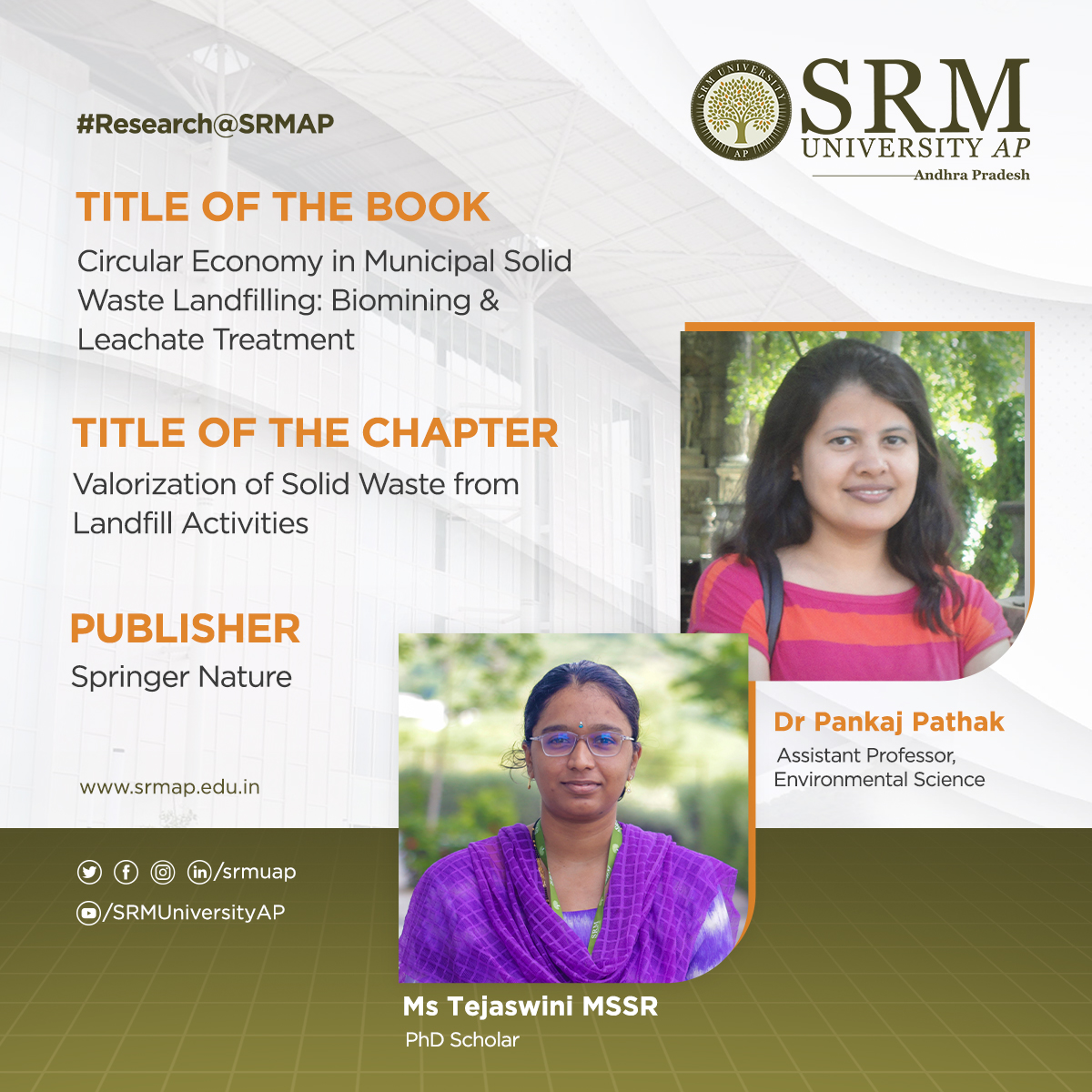
Dr Pankaj Pathak, Assistant Professor, Department of Environmental Science co-edited the book “Circular Economy in Municipal Solid Waste Landfilling: Biomining & Leachate Treatment: Sustainable Solid Waste Management: Waste to Wealth” in collaboration with Prof Sankar Ganesh Palani from BITS Pilani, Hyderabad. The book was released as part of the Springer publication series ‘Radionuclides and Heavy Metals in the Environment’ that covers issues pertaining to environmental pollution of air, water and soil, causative toxic agents, including radioactive materials, and remediation strategies.
The book is a ready reckoner of contemporary information regarding municipal solid waste landfill biomining, treatment of landfill leachate and heavy metals in a single platform. Construction of new landfills which requires huge monetary investments can be avoided if old landfills were bio-mined for resources and the space can be re-used as new landfills. Landfill leachate is a hazardous waste which needs proper treatment that could generate value-added products such as clean energy and biofertilizers. The book is a rich repository of information for academicians, researchers, and students at master’s and doctoral levels to understand the current trends in municipal solid waste landfill operations.
It also features the chapter, ”Valorization of Solid Waste from Landfill Activities” co-authored by Dr Pankaj Pathak and her PhD scholar MSSR Tejaswini along with Prof Sankar Ganesh Palani and Dr Prangya Ranjan Rout from Thapar Institute of Engineering and Technology. The article states that urban mining of various types of landfill wastes helps in the conservation of natural resources as well as increases the economic value of the disposed of wastes. It also ensures maximum recovery from the wastes that can be used as a secondary raw material for production purposes. Accordingly, they determine the environmental impacts associated with landfill wastes and identify different technologies that would help in the conversion of waste into resources through urban mining.
Essentially the book provides a circular economy approach to municipal solid waste (MSW) management. It also reviews the current technologies and future trends in MSW treatment by focusing on technological solutions for MSW treatment in developing countries in comparison with developed countries.
Continue reading → - Large-scale production of BP nanosheets September 1, 2022
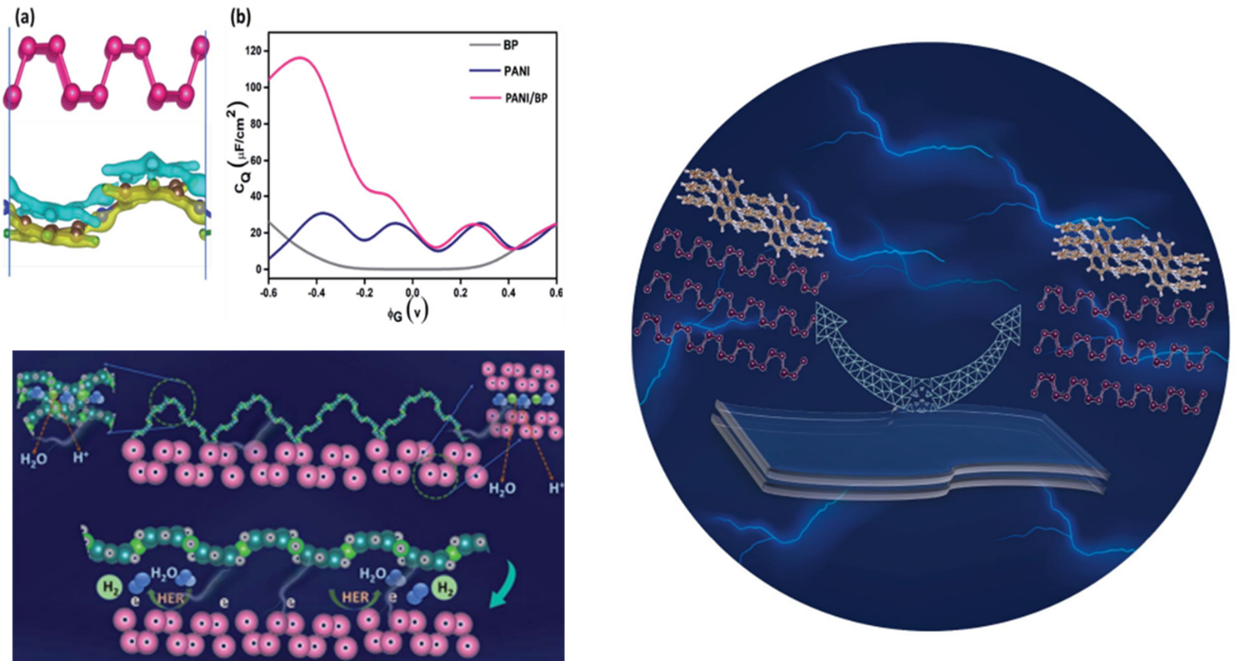 Research at the Department of Physics has effectively produced and characterised BP nanosheets on a large scale by a simple solvothermal approach, and the formation mechanisms are discussed. The paper, 2D-Black Phosphorus/Polyaniline Hybrids for Efficient Supercapacitor and Hydrogen Evolution Reaction Applications Check for updates, has been published by Prof Ranjit Thapa, Associate Dean of Sciences, as a corresponding author, and his PhD student, Mr Samadhan Kapse in Sustainable Energy & Fuels having an Impact Factor of 6.367.
Research at the Department of Physics has effectively produced and characterised BP nanosheets on a large scale by a simple solvothermal approach, and the formation mechanisms are discussed. The paper, 2D-Black Phosphorus/Polyaniline Hybrids for Efficient Supercapacitor and Hydrogen Evolution Reaction Applications Check for updates, has been published by Prof Ranjit Thapa, Associate Dean of Sciences, as a corresponding author, and his PhD student, Mr Samadhan Kapse in Sustainable Energy & Fuels having an Impact Factor of 6.367.Abstract
Black phosphorous (BP) is an emerging 2D material with exciting physicochemical properties with broad applicability in electronics. Stability in the ambient environment, large-scale synthesis, and volume expansion during the charge/discharge process hinder its application in energy storage. Here, we report a facile gram-scale synthesis of BP in a mild reaction condition by a simple and cost-effective wet chemical method. To overcome its degradation and sluggish electrochemical performance, an organic hybrid with polyaniline is also prepared. Further, we fabricated a flexible supercapacitor device which results in an exceptional specific capacitance of 969 mFcm-2 at a current density of 0.4 Acm-2, which displayed a high energy density of 21.5 mWhkg-1 at a power density of 231 mWkg-1 with good cycling stability of 91% after 4000 charge-discharge cycles. Similarly, the cyclic voltammetry studies of the flexible devices at various bending angles display a similar CV profile for all the bending angles, which confirms the device’s reliability for flexible applications.
Explanation of the research
BP-PANI hybrid materials were prepared by the in-situ chemical oxidation method. By this approach, the researchers got highly stable BP by an inorganic-organic linkage, and its energy storage performance was also investigated. The fabricated symmetric flexible supercapacitor device based on BP/PANI heterostructure exhibited an extraordinary specific capacitance of 969 mFcm-2 at a current density of 0.4 Acm-2. Moreover, the fabricated device showed a high energy density of 21.5 mWhkg-1 and a power density of 231 mWkg-1 with impressive cycle stability of 91% after 4000 charge-discharge cycles. This study paves the way for future research into gram-scale BP synthesis, stability via an inorganic-organic coupling, and its potential application in electrochemical energy storage devices.
Social implications of the research
With the rapid growth of portable/flexible electronics and the high demand for clean energy, supercapacitors have sparked interest due to their advantages of fast charge/discharge rates, long cycle life, and high-power density compared to conventional energy-storage devices such as dielectric capacitors and Li-ion batteries. Likewise, developing new functional materials with outstanding properties could shed light on many issues, including pollution, energy, synthesis, and cost. In recent years few graphene analogues materials have been explored, and because of their tuneable physicochemical properties, they were used in energy storage applications. Generally, black phosphorus was synthesised from polymorphs of phosphorus under vigorous reaction conditions. However, these high temperature/pressure conditions suffer from safety, toxicity, controllability, and gram-scale production.
Quantum capacitance is an efficient tool for rapidly screening materials for supercapacitor applications and therefore is the future of this research. The researchers have collaborated with Mr Namsheer K, Mr Mridula Manoj, Mr Aditya Sharma, and Dr Chandra Sekhar Rout from the Functional Materials & Devices Laboratory, Centre for Nano Material Sciences, Jain University, Bangalore, India, in this work.
Continue reading → - Efficient and selective single-atom catalysts for eNRR September 1, 2022

The Department of Physics is glad to announce that Dr Ranjit Thapa and his PhD scholar Mr Samadhan Kapse have published their research paper “Descriptors and graphical construction for in silico design of efficient and selective single-atom catalysts for eNRR” in the journal Chemical Science, having an Impact Factor of 9.969. The paper was published in collaboration with Prof Shobhana Narasimhan, Theoretical Sciences Unit and School of Advanced Materials, Jawaharlal Nehru Centre for Advanced Scientific Research, Bangalore. Chemical Science is a highly prestigious nature Index journal, which accepts only breakthrough research contributions for publication.
The Haber-Bosch process for ammonia synthesis has been described as possibly the most important scientific discovery of the twentieth century. However, it requires high temperatures and pressures and results in large energy consumption and emission of greenhouse gases. That is where electrochemical nitrogen reduction reaction (eNRR) comes into the picture. It synthesizes ammonia from nitrogen and water under mild conditions (N2 + 6H+ + 6e- → 2NH3). However, currently available eNRR catalysts need improvement in three respects: (i) the efficiency of nitrogen fixation needs to be increased, (ii) the competing hydrogen evolution reaction (HER) needs to be suppressed, and (iii) hydrogen poisoning of active sites must be avoided. Transition metals are popular eNRR catalysts; however, they tend to favour hydrogen adsorption due to the formation of strong metal d – hydrogen σ bonds, and tend to have a low affinity for N2 adsorption. Their research mitigates these problems by appropriately tuning the electronic structure by altering the environment surrounding metal atoms at the active site of single-atom catalysts (SACs). Moreover, in previous works, typically, only one criterion (usually competing HER) was used to optimize catalyst function, whereas they simultaneously optimised the catalyst function with respect to multiple criteria.

They have screened 66 different transition metal-based SACs for possible use in eNRR. To determine the best possible catalyst, they considered three factors: N2 adsorption, hydrogen poisoning and the overpotential of eNRR. Here, the valence electron occupancy (Oval) is identified as a new electronic descriptor that can predict the overpotential value. They emphasised that having a low η_NRR alone does not suffice to indicate a suitable eNRR catalyst, since if the adsorption free energy is higher for H than N2, active sites will be poisoned, hindering eNRR. Thus, they present a simple graphical procedure for identifying the most promising catalysts. To carry out this procedure, one must compute only 〖ΔG〗_(H^* ) and 〖ΔG〗_(NNH^* ), the changes in the free energies of H and NNH adsorption, respectively (note that η_NRR can be deduced if 〖ΔG〗_(NNH^* ) is known). The most promising candidate is identified as Sc-Pc, which they predict will have no H poisoning and will be highly selective for eNRR over HER. Moreover, they predict that Mn-Pc, Cr-N4, Fe-N2C2 should also be highly efficient, with low overpotential (η_NRR < 1 V) toward eNRR, and no H poisoning. In future they aim to find the selective materials for catalytic reactions by studying the origin of activity, reaction mechanism, etc.
Abstract of the Research
The electrochemical nitrogen reduction reaction (eNRR) offers the possibility of ammonia synthesis under mild conditions; however, it suffers from low yields, a competing hydrogen evolution reaction pathway, and hydrogen poisoning. We present a systematic approach toward screening single atom catalysts (SACs) for eNRR, by focusing on key parameters computed from density functional theory, and relationships between them. We illustrate this by application to 66 model catalysts of the types, TM-Pc, TM-NXCY, and TM-N3, where TM is a 3d transition metal or molybdenum. We identified the best SACs as Sc-Pc, Cr-N4, Mn-Pc, and Fe-N2C2; these show eNRR selectivity over HER and no hydrogen poisoning. The catalysts are identified through multi-parameter optimization which includes the condition of hydrogen poisoning. We propose a new electronic descriptor Oval, the valence electron occupancy of the metal center, that exhibits a volcano-type relationship with eNRR overpotential. Our multi-parameter optimization approach can be mapped onto a simple graphical construction to find the best catalyst for eNRR over HER and hydrogen poisoning.
- SRM AP begins the youth empowerment and skill development programme August 30, 2022
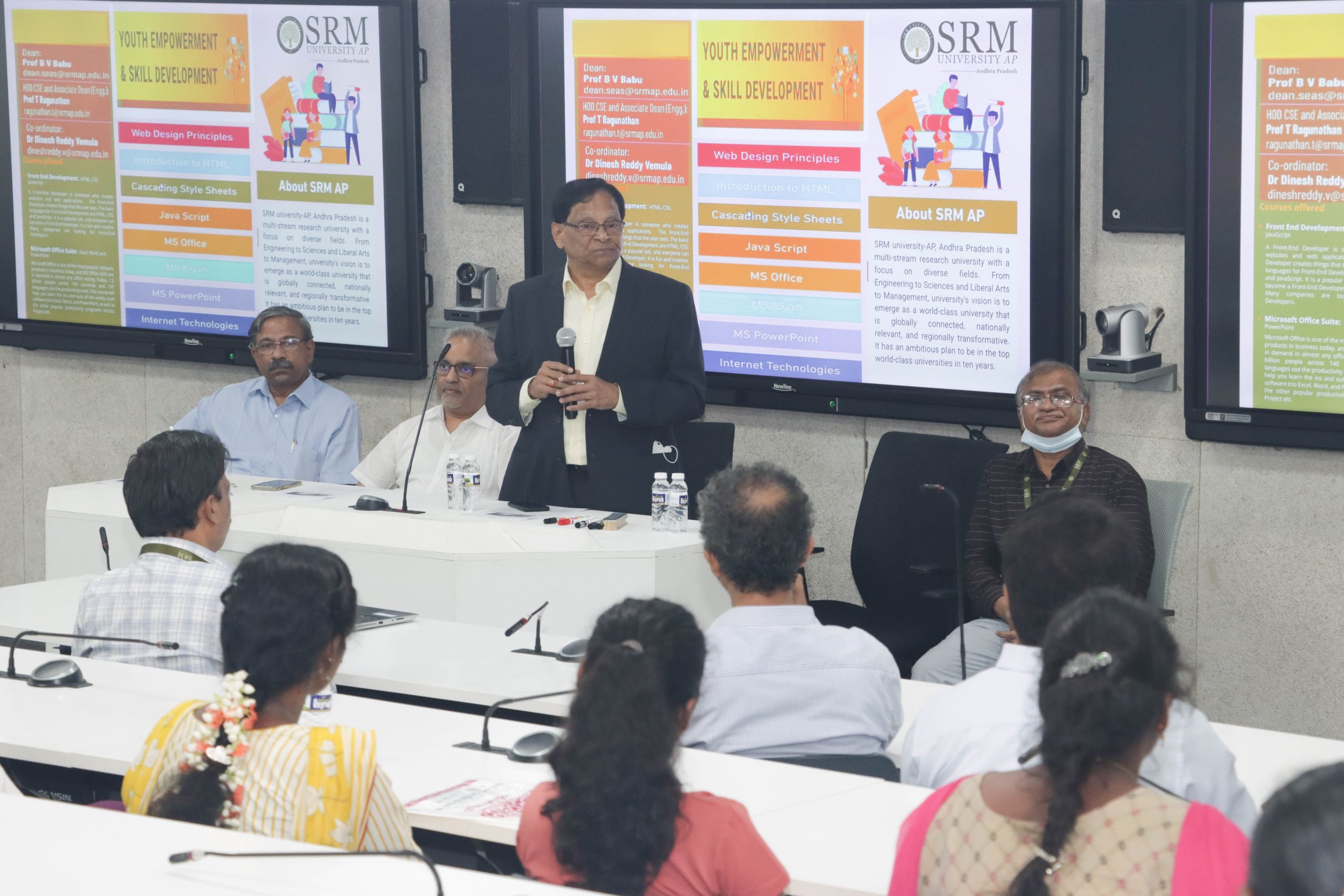
The Department of Computer Science and Engineering at SRM University-AP commenced a one-month-long programme on “Youth Empowerment and Skill Development” with its inaugural ceremony on August 29, 2022. The programme, organised under the ISR activities of the university, is an exclusive initiative for young people living in the vicinal rural communities to enhance and develop their technical and computing skills that will augment their possibilities for a better livelihood.
At the inaugural function, Prof T Ragunathan, Associate Dean- SEAS & the Head of the Department welcomed the gathering. He expressed the university’s objective in conducting the programme and how it would create far-reaching implications in the personal and professional development of the rural youth. Honourable Vice-Chancellor Prof VS Rao delivered the inaugural address and appreciated such dedicated and active initiatives aiming at the holistic welfare of society. “Equitable development of the society should be the vision of the modern education, enabling the young generation of this country to grow into the greatest wealth of our nation”, he remarked.
Prof BV Babu, Dean-SEAS presided over and emphasised the necessity of facilitating and preparing the youth to face the challenges of a technology-driven world. Digital literacy and computer awareness have become the inevitability of present times, causing a marked shift in the operations of the secondary and tertiary sectors. Registrar Dr R Premkumar also addressed the gathering. An empowered youth with digital and computer expertise will keep the country’s future safe in their hands. The Programme coordinator Dr V Dinesh Reddy, Assistant Professor- Department of Computer Science and Engineering proposed the vote of thanks.
The programme received an overwhelming response from around fifteen neighbouring villages. As part of the workshop, courses will be offered on web designing and internet technologies such as Front-End Development and Microsoft Office Suite.. Students will be introduced to basic web designing principles, MS office, Javascript, HTML, etc. Classes will be held from August 29, 2022, to September 28, 2022, from 5.30 pm to 7.00 pm at the university premises.
- DST-SATHI cluster with KLU, ANU, Vignan University and AIIMS August 30, 2022
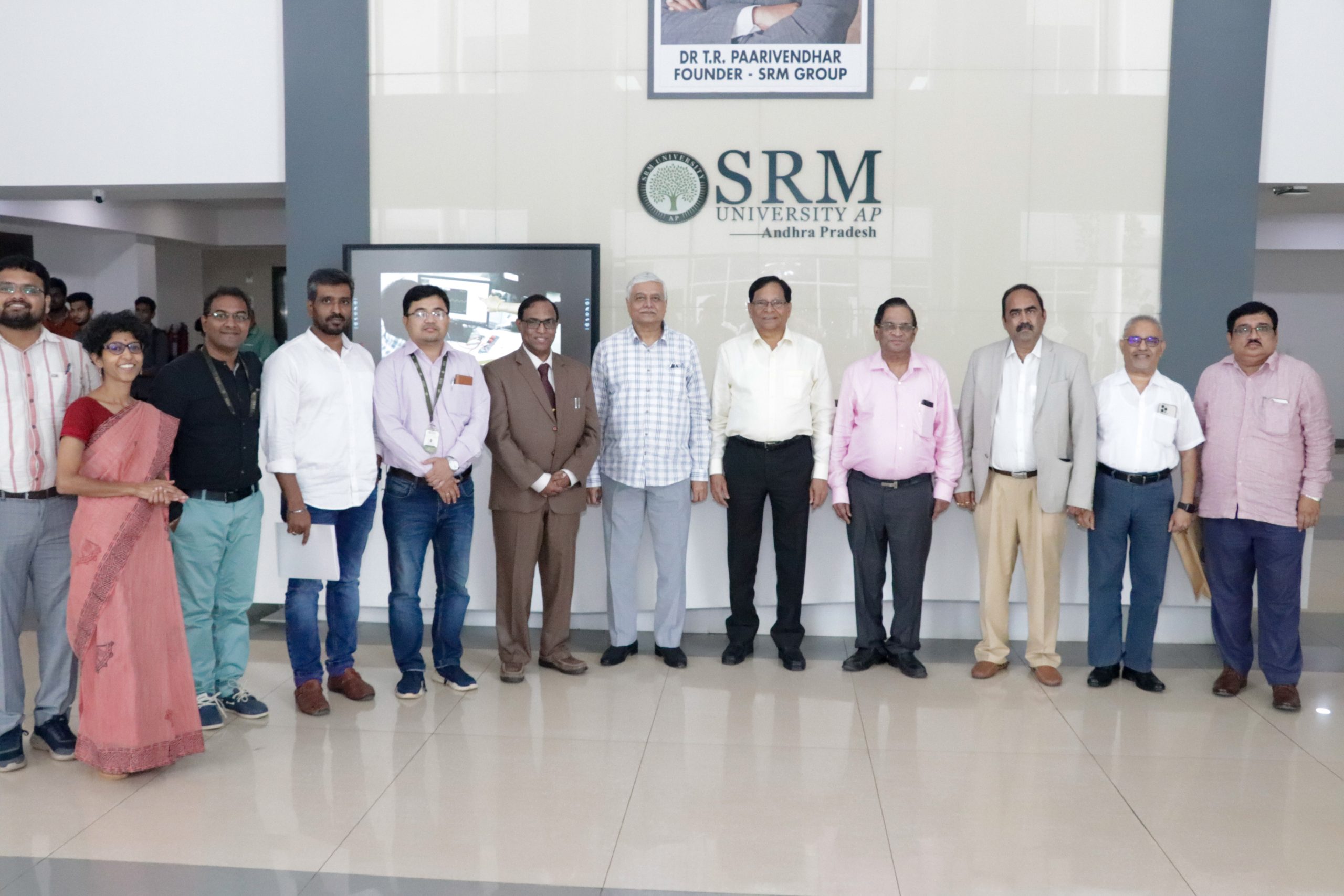 SRM University-AP formed a cluster with Acharya Nagarjuna University, KL University, Vignan University, and AIIMS Mangalagiri for the DST-SATHI initiative of the Ministry of Science and Technology. Sophisticated Analytical & Technical Help Institute (SATHI) aims to provide professionally managed services with efficiency, accessibility and transparency of the highest order under one roof to service the demands of industry, start-ups and academia. Dr P Siddaiah – Dean, Acharya Nagarjuna University; Dr Mukesh Tripathi, Director-AIIMS Mangalagiri; Dr G Pardha Saradhi Varma – Vice Chancellor, KL University; and Dr P Nagabhushan – Vice Chancellor, Vignan University; attended the meeting held at SRM University-AP campus on Monday.
SRM University-AP formed a cluster with Acharya Nagarjuna University, KL University, Vignan University, and AIIMS Mangalagiri for the DST-SATHI initiative of the Ministry of Science and Technology. Sophisticated Analytical & Technical Help Institute (SATHI) aims to provide professionally managed services with efficiency, accessibility and transparency of the highest order under one roof to service the demands of industry, start-ups and academia. Dr P Siddaiah – Dean, Acharya Nagarjuna University; Dr Mukesh Tripathi, Director-AIIMS Mangalagiri; Dr G Pardha Saradhi Varma – Vice Chancellor, KL University; and Dr P Nagabhushan – Vice Chancellor, Vignan University; attended the meeting held at SRM University-AP campus on Monday.SRM AP Vice-Chancellor Prof V S Rao invited the Vice-Chancellors of the respective universities to come forward for the formation of a cluster for the ‘SATHI’ programme. Pro-Vice Chancellor Prof D Narayana Rao did an elaborate presentation on DST projects. “The host institute, which is the lead partner in the cluster, will have to provide a functional space of 20,000 square yards, and SRM University-AP is suitable for this in every way”, Prof D Narayana Rao said. “The equipment worth Rs 75 crore to be provided through the SATHI programme will help in carrying out extensive research in all the five universities,” he added. The Vice-Chancellors and Directors of these 5 institutions have agreed to form the cluster and submit the proposal to the Department of Science & Technology (DST), Government of India. Professors of SRM AP and representatives of respective universities also attended the meeting.
Continue reading → - SRM University- AP inked MoU with Rennes Business School August 29, 2022
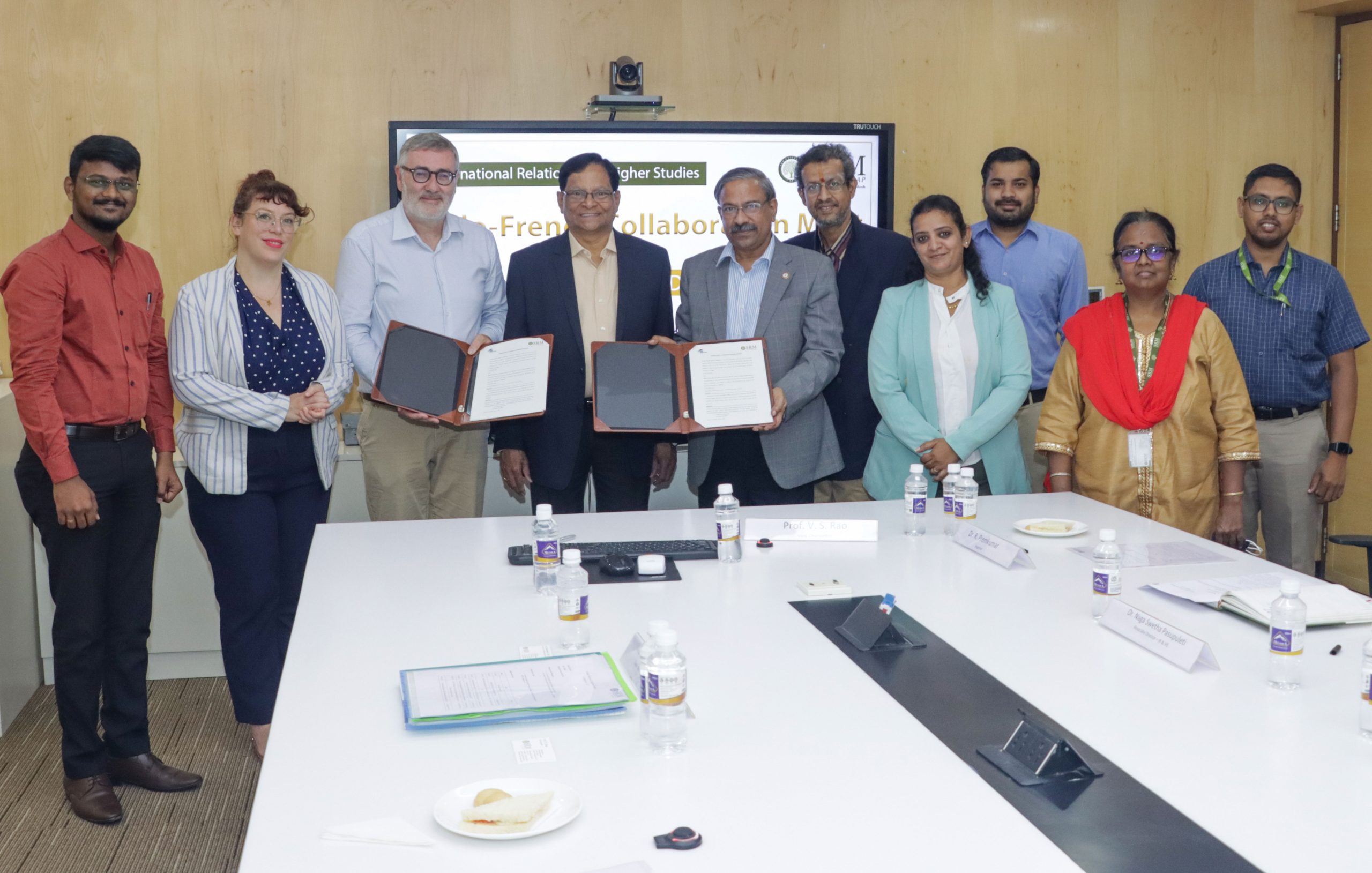 Indo-French diplomatic relations have always tailored development across all major disciplines. SRM University- AP has inked an MoU with the Rennes School of Business on August 23, 2022. The two institutions agreed to promote mutually beneficial activities in education, research, and other academic areas. The alliance in specific targets the internationalisation of higher education.
Indo-French diplomatic relations have always tailored development across all major disciplines. SRM University- AP has inked an MoU with the Rennes School of Business on August 23, 2022. The two institutions agreed to promote mutually beneficial activities in education, research, and other academic areas. The alliance in specific targets the internationalisation of higher education.SRM University- AP aspire to strengthen the ties with Rennes School of Business following the mutual interests in delivering programmes of academic excellence and cultural diversity. Honourable Vice-Chancellor Prof V S Rao commented that the collaboration would open the gates of higher studies and research work for SRM University- AP and Rennes Business School. Both institutions are determined to work together with the spirit of prolific international relations and academic cooperation.
Dr Thomas Froehlicher, Dean, Rennes School of Business, and Ms Maud LE BARS, South Asia Area Manager, Rennes School of Business, were the delegates who visited the campus to sign the MoU. “India and France share common historical events and many cultures. This collaboration will benefit both the nations and the students”, said Dr Thomas as he briefed his thoughts on the alliance.
The coordination between the institutes may include but is not limited to progression programmes and semester abroad programmes. The agreement looks forward to organising executive programmes for the professional community, joint research projects, joint conferences and publications, exchange of faculty members, collaborative virtual student projects, short study abroad seminars, executive education, and admission to degree-seeking students on a fee-paying basis.
Dr Bharadwaj, Dean SEAMS, Dr CA Mahalakshmi Mudliar, Associate Professor of SEAMS, and Dr Naga Swetha Pasupuleti, Associate Director of International Relations, had a vigorous discussion with the Rennes business school representatives regarding the areas of collaboration. Dr R Premkumar, Registrar and Dr Thomas Froehlicher, Dean of Rennes Business School, signed the MOU and exchanged the documents.
Continue reading → - Prof G S Vinod Kumar to be the Chief Faculty Mentor of Patent Maker August 26, 2022
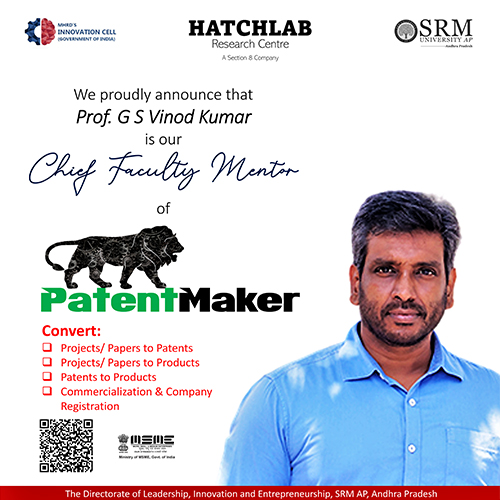 The Hatchlab Research Centre has been nurturing innovative ideas and inspirational ambitions for paving the way to an extraordinary tomorrow. Patent Maker was the beginning of a new chapter in these explorations, armed with the potential to work out the unworkable. The Directorate of Entrepreneurship and Innovations and is glad to announce that Prof G S Vinod Kumar, Department of Mechanical Engineering, has been appointed as the Chief Faculty Mentor of Patent Maker.
The Hatchlab Research Centre has been nurturing innovative ideas and inspirational ambitions for paving the way to an extraordinary tomorrow. Patent Maker was the beginning of a new chapter in these explorations, armed with the potential to work out the unworkable. The Directorate of Entrepreneurship and Innovations and is glad to announce that Prof G S Vinod Kumar, Department of Mechanical Engineering, has been appointed as the Chief Faculty Mentor of Patent Maker.Prof G S Vinod Kumar, an expert, mentor, and multidimensional professional, has been there from the very inception of this initiative. Patent Maker is a common platform which will not only facilitate the conversion of ideas, products, concepts, and research papers to patents but will also help them commercialise with the help and support of the industry. It encourages every aspirant who wants to contribute to the nation and bridges the gap between industry and academia.
Hatchlab Research Centre believes in the power of connection and creates opportunities for students to converse their field of interest with experts around the map. The team actively engages in the university’s innovation, research, and entrepreneurship activities. The focus also relies on concreting a start-up ecosystem with the help of corporates, enablers, world-class mentors, top-class institutions, foundations, incubators, and the government. Patent Maker is one of the biggest initiatives of the Hatchlab Research Centre. It aspires to be a support system for projects and patents that deserve a high commercial application.
Continue reading → - A multifarious study on Low-Power Wide-Area Networks August 25, 2022

The Department of Electronics and Communication Engineering is delighted to announce that Assistant Professor Dr Anirban Ghosh and Research Scholar Mr Naga Srinivasarao Chilamkurthy have published their article titled “Low-Power Wide-Area Networks: A Broad Overview of its different aspects” in IEEE Access, a Q1 Journal, having an Impact Factor of 3.476. The work was published in collaboration with Dr Om Jee Pandey from the Indian Institute of Technology BHU, Dr Cenkeramaddi Linga Reddy from the University of Agder, and Dr Hong-Ning Dai from Hong Kong Baptist University, Hong Kong.
This is a survey article on Low-power Wide-area networks which provides a detailed description of LPWAN technologies in the context of IoT applications. In this survey article, they review and provide an overarching description of LPWAN in terms of design goals, techniques to improve design objectives, and system architecture. They have also evaluated several existing and non-standardized LPWAN technologies and the market opportunities of LPWAN. With the help of this article, the researchers can choose the best LPWAN technology for their specific applications.
The practical implementation of the article can be found in various social and commercial applications such as smart healthcare, intelligent transportation, climate-smart agriculture, rescue operations, logistics, smart cities, industries, utilities, smart buildings, consumer electronics, security, asset tracking, smart waste management systems, cognitive manufacturing, and Machine-to-Machine (M2M) communications. Their future research plans include working on Wireless Sensor Networks, Low-Power Wide-Area Networks, Small-World Networks, and applying machine learning and reinforcement learning techniques in the context of wireless networks for cyber-physical systems and IoT applications.
Abstract of the Research
Low-power wide-area networks (LPWANs) are gaining popularity in the research community due to their low power consumption, low cost, and wide geographical coverage. LPWAN technologies complement and outperform short-range and traditional cellular wireless technologies in a variety of applications, including smart city development, machine-to-machine (M2M) communications, healthcare, intelligent transportation, industrial applications, climate-smart agriculture, and asset tracking. This review paper discusses the design objectives and the methodologies used by LPWAN to provide extensive coverage for low-power devices. We also explore how the presented LPWAN architecture employs various topologies such as star and mesh. We examine many current and emerging LPWAN technologies, as well as their system architectures and standards, and evaluate their ability to meet each design objective. In addition, the possible coexistence of LPWAN with other technologies, combining the best attributes to provide an optimum solution is also explored and reported in the current overview. Following that, a comparison of various LPWAN technologies is performed, and their market opportunities are also investigated. Furthermore, an analysis of various LPWAN use cases is performed, highlighting their benefits and drawbacks. This aids in the selection of the best LPWAN technology for various applications. Before concluding the work, the open research issues, and challenges in designing LPWAN are presented.
- SRM AP observes Prerana Vanam on Founder’s Day August 24, 2022
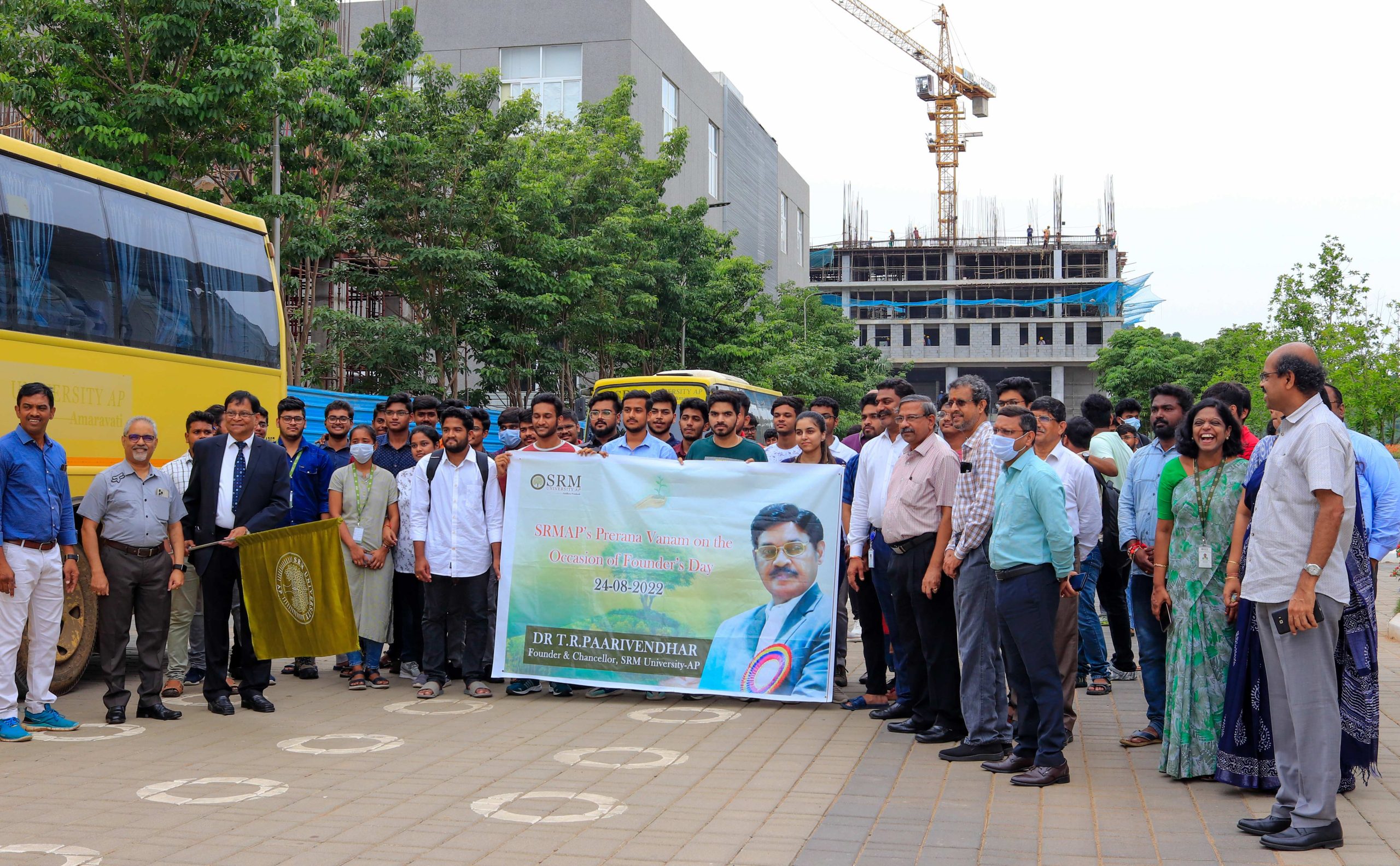 SRM University-AP celebrated the birthday of Founder Chancellor Dr T R Paarivendhar as Founder’s Day on August 24, 2022. The university observed Prerana Vanam and planted trees in the nearby village, Neerukonda, as a part of the celebrations. Prof V S Rao, Vice-Chancellor; and Dr R Premkumar, Registrar; addressed the gathering.
SRM University-AP celebrated the birthday of Founder Chancellor Dr T R Paarivendhar as Founder’s Day on August 24, 2022. The university observed Prerana Vanam and planted trees in the nearby village, Neerukonda, as a part of the celebrations. Prof V S Rao, Vice-Chancellor; and Dr R Premkumar, Registrar; addressed the gathering.In his address, Vice-Chancellor Prof V S Rao commended the services rendered by Dr T R Paarivendhar for the progress of the education sector. He advised the students to move forward by taking inspiration from the Chancellor. Speaking on the occasion, Deans and Directors paid tributes to the leadership of Hon’ble Chancellor. They further explicated the benefits of growing trees and how that sustainably contributes to the oxygen level in the atmosphere.
Prerana Vanam is an initiative by SRM University-AP to fundamentally raise awareness among people about the importance of ecosystem preservation. The formal event held at the university campus was attended by students, staff, and faculty members of the university. The celebration continued with the students visiting and distributing fruits at an Old Age Home and Orphanage in Mangalagiri. Prof V S Rao lauded the gesture of the students that extends services to society.
Continue reading →


